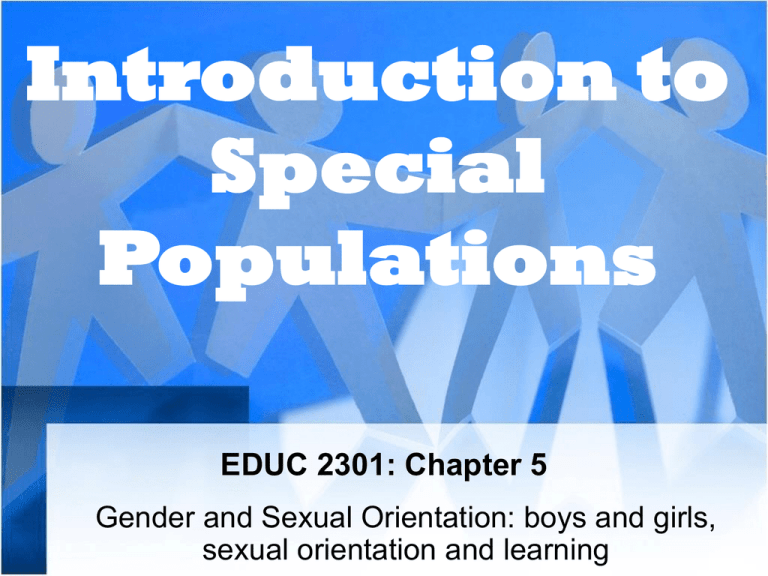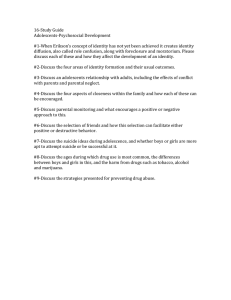
Introduction to
Special
Populations
EDUC 2301: Chapter 5
Gender and Sexual Orientation: boys and girls,
sexual orientation and learning
Perspectives on Gender Identity
2
• The development of one’s sense of
identity—the knowledge that one is
separate from parents and family—
begins early.
• A critical part of identity development,
beginning at least at birth, is gender.
• Gender is our social and legal status as
girls and boys, women and men
• Gender identity is how you feel about and
express your gender (clothes, behavior,
appearance)
Sex and Gender Identity
• Identification in terms of sex begins at
about 18 months of age—“I am a girl,” “I
am a boy.”
• Sex is a biological characteristic (genetic
make-up, hormones, body parts)
• Gender is social one—what it means to
be a boy or girl in any given society; what
the rules are, what it means to be
feminine or masculine
3
Gender Role Socialization
• The rules associated with one’s gender
role may vary by race, ethnicity, social
class, religion, and even by geographical
region.
• The process of learning one’s gender
role can be described in three parts, as
follows:
4
5
• The child learns to distinguish between
men and women, boys and girls, and to
know what kinds of behavior are
characteristic of each;
• The child learns to express appropriate
gender role preferences for himself or
herself;
• The child internalizes the “rules” and
learns to behave in accordance with
gender role standards.
Gender Stereotypes
•
•
•
•
•
Personality traits
Domestic behaviors
Occupations
Physical Appearance
Extremes – hyperfemininity and
hypermasculinity
• Addressing Gender Stereotypes
– Speak up (challenge sexist jokes, attitudes)
– Be a role model
– Give it a try (do things not normally done)
The Impact of Gender in the School
Social Component
• Play Mates
• Play Spaces
• Play Styles
• Play Themes
– 1 year old girls look longer
at film of human faces,
boys look longer at film of
cars
• Resolving Conflicts
– Girls more empathetic
Implications for Teachers
• Respect
• Outdoor and Indoor
• Balanced activities
• Wide variety of materials
– 95% of teachers of young
children are female and
choose materials to
minimize
competition…boys find
their books and activities
boring
• Rules and strategies
Gender Role Socialization
in the Middle Class
• Parents:
– Boys handled more roughly, girls get more
verbal attention
– Boys given more freedom to explore; girls
kept closer to supervising parent
– Girls get more help in solving problems;
boys told to “figure it out”
– Parents’ approval of “appropriate” gender
behavior shapes the behavior of children
8
Other Socializing Agents
• Television
• Children’s books
– Need adventure books to maintain interest in
boys
• Children’s toys
• Nursery rhymes, religious stories
• Proverbs and sayings
9
Gender Differences in Approach to
Sexuatlity
• Teen girls and female college students
who are sexually active are much more
likely to
– Get STD’s
– Experience later infertility and cancer
– Be emotionally harmed – feeling used, hurt
and demeaned
– Experience clinical depression
Gender as an Issue of
Legal Equity in Schools
• Title IX, Educational Amendments (1972)
“No person in the United States shall, on
the basis of sex, be excluded from
participation in, be denied the benefits of,
or be subjected to discrimination under
any educational program or activity
receiving federal financial assistance.”
11
Some Important Court Cases
• Grove City v. Bell (1984)—Supreme Court
agrees that schools that do not receive direct
federal funds can be excluded from Title IX
• Civil Rights Restoration Act (1988)—overrode
Bell; required all education institutions
receiving any federal funds (e.g., student
loans) must comply with Title IX
• Numerous cases have been brought in lower
courts on the question of girls’ athletics; most
have affirmed Title IX.
12
• Sexual harassment; the results have been
mixed in adult-on-student cases:
– Franklin v. Gwinnett County Public Schools
(1992)—petitioners may claim punitive damages
under Title IX when intent to evade compliance is
established
– Gebser and Mccullough v. Lago Vista Independent
School District (1997)—denied compensatory
damages from both the teacher involved and the
school district
• Student-on-student harassment case
– Doe v. Petaluma Unified School District (1995)—
plaintiff was awarded punitive damages of $250,000
13
Major Studies on Gender and
Schooling in the Last Decade
• Mid-Atlantic Equity Center and
NETWORK Study (1993) found eight
areas of concern related to Title IX still to
be addressed in order to ensure equal
educational opportunity for all students,
as follows:
14
15
– Girls & boys at risk of dropping out of school
– Gender bias in student–teacher interactions
– Participation and achievement of girls in math
and science
– Students enrolling and completing vocational
education courses historically nontraditional to
their gender
– Gender bias in standardized tests
– Gender differences in learning styles
– Teen pregnancy and parenting
– Sexual harassment of students by their peers
Educating Our Boys
• Boys are now falling behind in reading,
according to a 50-state survey released
in 2011 by Center on Education Policy
• 62% of Community College graduates
are female; 57% of students earning
bachelor degrees are female
• “Raising Cain”
Ethical Issues
17
• The degree to which all students are
encouraged to be open, reflective, and critical
thinkers
• The degree to which open inquiry may place
students at odds with their families or the
community – use good judgment, insistence on
political correctness can do more harm than
good
• The degree to which the role of the school is
seen as one which helps all students to
understand, appreciate, and negotiate
differences—of gender and sexuality as well as
of other characteristics
Equity through Respect and
Balance
• Teaching strategies must be informed by a
comprehensive knowledge of gender socialization and
its effect on human development and learning. In
addition, teachers must be aware of their power and its
use in the classroom and how male and female
students experience power differently.
• It is possible to be equitable in language and behavior
while affirming contrary beliefs
• Teachers must be aware of and continually review their
own values and biases toward both males and females
in order to be advocates for equityy and equal
opportunities for boys and girls in schools.
.



